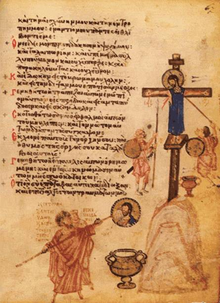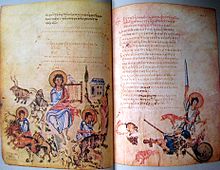Chludow Psalter

The Chludow Psalter is an illuminated Byzantine manuscript from the middle of the 9th century. It is the oldest of three surviving illuminated psalters from this period. The subject of part of his miniatures is the iconoclasm in the Byzantine Empire in the first half of the 9th century. The unusually polemical style of the work proves the passion of the iconoclasts versus iconodules . His use of caricature as a style of political debate in a liturgical textbook is unique .
history
According to Nikodim Kondakov , the psalter was written in the studio monastery in Constantinople. Other scholars believe that the liturgical answers given in the text were only given in Hagia Sophia and that the Psalter was therefore made in the Imperial Workshops of Constantinople in 843, shortly after the iconodules returned to power.
The Psalter was kept on Mount Athos until the Russian Slavist Viktor Grigorovich brought it to Moscow in 1847 . There it was bought by the old-believing businessman and art collector Alexei Ivanovich Chludow , whose name he received. As part of the Chludov legacy, the psalter went to the Nikolaikloster and has been kept in the State Historical Museum in Moscow since 1917 (Moscow, Hist. Mus. MS. Gr.129d).
description
The psalter measures 195 mm × 150 mm and contains 169 folia . The outer edge of the pages was usually left blank for illustrations. The text and captions consisted of small uncials , many of which were overwritten with crude minuscule about three centuries later . The book contains the Psalms in the version of the Septuagint and the responsories that occurred during their recitation according to the liturgy of Hagia Sophia .
The Chludow Psalter is considered to be the first psalter in which the illustrations contain additional textual explanations to the drawings as well as small arrows that point out of the text to the illustrations to make it clear which line the illustration refers to. The content of the miniatures is not limited to the canonical Christian subjects - the edges of the manuscript depict the historical personalities of the time of the Byzantine iconoclasm, the miniatures reflect the disputes in the social life of the epoch.
On folio 67 r of Chludow Psalter illustrated the miniaturist Psalm 69, verse 21: "They give me food and vinegar to drink for my thirst bile." ( Ps 69.22 LUT ). The crucifixion of Jesus Christ on Golgotha is shown in the background . A soldier hands Christ a sponge soaked in vinegar on a pole. In front of it is a depiction of the last iconoclastic patriarch of Constantinople , John VII Grammatikos , who erases an image of Christ with a similar sponge on a pole. Here as on other pages, Johannes Grammatikos was caricatured with tangled hair sticking out in all directions, in order to make him look ridiculous among the elegant Byzantines.
Individual evidence
- ↑ N. Malitzki: “Le psautier byzantin à illustrations marginales du type Chludov est-il de provenance monastique?” L'art byzantin chez le slaves , II. Paris 1932, 235–243.
- ^ Byzantine and early Christian art ( Memento of February 26, 2008 in the Internet Archive ) (Russian).
literature
- Robin Cormack: Writing in gold: Byzantine society and its icons . George Philip, London 1985, ISBN 0-540-01085-5
- W. Lazarew: Some critical remarks on the Chludov Psalter . Byzantine Journal , XXIX 1930 3–4, 283–284
